浅谈肢体语言在商务谈判中的作用
- 格式:doc
- 大小:71.50 KB
- 文档页数:9
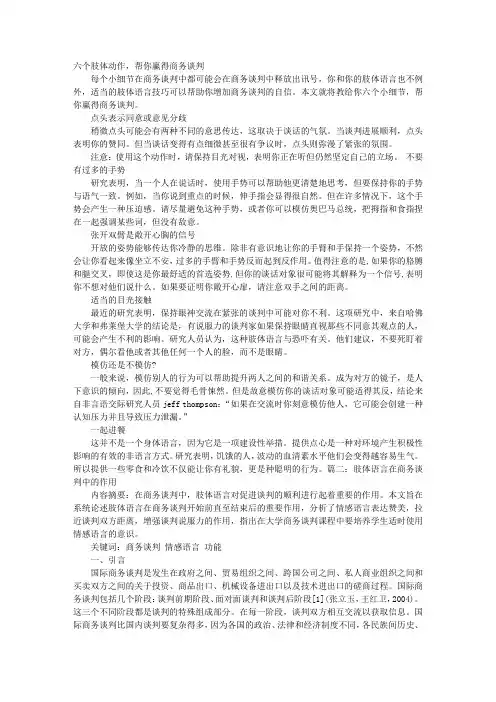
六个肢体动作,帮你赢得商务谈判每个小细节在商务谈判中都可能会在商务谈判中释放出讯号,你和你的肢体语言也不例外,适当的肢体语言技巧可以帮助你增加商务谈判的自信。
本文就将教给你六个小细节,帮你赢得商务谈判。
点头表示同意或意见分歧稍微点头可能会有两种不同的意思传达,这取决于谈话的气氛。
当谈判进展顺利,点头表明你的赞同。
但当谈话变得有点细微甚至很有争议时,点头则弥漫了紧张的氛围。
注意:使用这个动作时,请保持目光对视,表明你正在听但仍然坚定自己的立场。
不要有过多的手势研究表明,当一个人在说话时,使用手势可以帮助他更清楚地思考,但要保持你的手势与语气一致。
例如,当你说到重点的时候,伸手指会显得很自然。
但在许多情况下,这个手势会产生一种压迫感。
请尽量避免这种手势,或者你可以模仿奥巴马总统,把拇指和食指捏在一起强调某些词,但没有敌意。
张开双臂是敞开心胸的信号开放的姿势能够传达你冷静的思维。
除非有意识地让你的手臂和手保持一个姿势,不然会让你看起来像坐立不安,过多的手臂和手势反而起到反作用。
值得注意的是,如果你的胳膊和腿交叉,即使这是你最舒适的首选姿势,但你的谈话对象很可能将其解释为一个信号,表明你不想对他们说什么。
如果要证明你敞开心扉,请注意双手之间的距离。
适当的目光接触最近的研究表明,保持眼神交流在紧张的谈判中可能对你不利。
这项研究中,来自哈佛大学和弗莱堡大学的结论是,有说服力的谈判家如果保持眼睛直视那些不同意其观点的人,可能会产生不利的影响。
研究人员认为,这种肢体语言与恐吓有关。
他们建议,不要死盯着对方,偶尔看他或者其他任何一个人的脸,而不是眼睛。
模仿还是不模仿?一般来说,模仿别人的行为可以帮助提升两人之间的和谐关系。
成为对方的镜子,是人下意识的倾向,因此,不要觉得毛骨悚然。
但是故意模仿你的谈话对象可能适得其反,结论来自非言语交际研究人员jeff thompson:“如果在交流时你刻意模仿他人,它可能会创建一种认知压力并且导致压力泄漏。
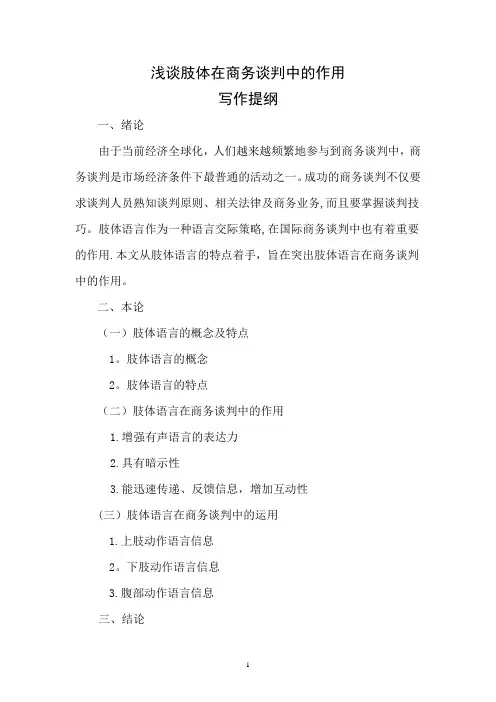
浅谈肢体在商务谈判中的作用写作提纲一、绪论由于当前经济全球化,人们越来越频繁地参与到商务谈判中,商务谈判是市场经济条件下最普通的活动之一。
成功的商务谈判不仅要求谈判人员熟知谈判原则、相关法律及商务业务,而且要掌握谈判技巧。
肢体语言作为一种语言交际策略,在国际商务谈判中也有着重要的作用.本文从肢体语言的特点着手,旨在突出肢体语言在商务谈判中的作用。
二、本论(一)肢体语言的概念及特点1。
肢体语言的概念2。
肢体语言的特点(二)肢体语言在商务谈判中的作用1.增强有声语言的表达力2.具有暗示性3.能迅速传递、反馈信息,增加互动性(三)肢体语言在商务谈判中的运用1.上肢动作语言信息2。
下肢动作语言信息3.腹部动作语言信息三、结论随着商务交流的日益频繁,商务谈判也越来越受到商务人士的关注,肢体语言作为商务谈判中重要策略之一,也越来越被谈判者重视,肢体语言的真实和不易伪装在谈判过程中占主导地位,因此有效地利用商务谈判中的语言也是非常重要的。
浅谈肢体语言在商务谈判中的作用饶慕容【内容摘要】近年来,我国与世界各国的国际商务关系不断地发展变化,商务谈判在跨国商务和国际经济活动中日益频繁。
肢体语言作为商务谈判中重要的一部分,其作用也是非常重要的。
本文就肢体语言在商务谈判中的作用提出了在商务谈判中上肢动作、下肢动作和腹部动作三大肢体的语言信息,力求把握好肢体语言技巧,让商务谈判更好更顺利的进行。
【关键词】肢体语言商务谈判作用由于当前经济全球化,人们越来越频繁地参与到商务谈判中,商务谈判是市场经济条件下最普通的活动之一.成功的商务谈判要求谈判人员不仅要熟知谈判原则、相关法律和商务业务,而且要掌握谈判技巧.肢体语言作为商务谈判中重要的一部分,在商务谈判中也有着重要的作用.本文就肢体语言的特点着手,旨在突出肢体语言在商务谈判中的作用。
一、肢体语言的概念及特点(一)肢体语言的概念肢体语言又称身体语言,是指非语言性的身体符号,包括眼神与面部表情、身体运动与触摸、姿势、身体间的空间距离等,是除语言表达外另一种重要的沟通方式广义言之,肢体语言也包括前述之面部表情在内;狭义言之,肢体语言只包括身体与四肢所表达的意义。

浅析肢体语言对国际商务谈判的作用摘要:随着经济技术的发展,越来越多的人们参与到商务交流中,商务谈判在国际经济活动中日益频繁.肢体语言作为商务谈判中一个较为特殊的部分,他所体现的真实性和无意识性在商务谈判中起着重要的作用,越来越为谈判者所重视本文就肢体语言的表现形式着手,力求把握好肢体语言技巧,让商务谈判更好更顺利的进行。
关键词:肢体语言商务谈判作用目录摘要 (1)关键词 (1)一、肢体语言的定义 (3)二、肢体语言在商务谈判中的作用 (3)(一)增强语言的表达力 (3)(二)代替有声语言 (3)(三)迅速准确的传递信息 (4)(四)调节作用 (4)三、肢体语言的表现形式 (4)四、肢体语言在商务谈判中的应用 (5)(一)脸部表情 (5)(二)手部动作 (6)(三)腿动作语言信息 (6)(四)头部动作 (7)结论 (7)参考文献 (7)一、肢体语言的定义肢体语言又称身体语言,是指通过头、眼、颈、手、肘、臂、身、胯、足等人体部位的协调活动来传达人物的思想,形象地借以表情达意的一种沟通方式:所谓商务谈判,是指买卖双方为了促成交易,满足双方的利益,或是为了解决买卖双方的争端,就所关心的问题而进行的磋商,并取得各自的经济利益的一种方法和手段。
二、肢体语言在商务谈判中的作用(一)增强语言的表达力人们往往利用话语表达思想,传递情感,但偶尔也会发生词不达意的情况,为此还应利用肢体语言进行补充,以弥补有声语言的缺陷,从而可以强调自己想表达的意思。
比如当别人向你问路时,此时你会边利用有声语言进行指向,而后手指也会为其指明道路方向。
同时,肢体语言也可以多方面的表达意思,可以在谈判桌上向对方传递丰富微妙的情感,使有声语言更具感染效力。
(二)代替有声语言一定条件下,肢体语言也会取代人们的有声语言,且具备有声语言所不具备的优势与特点。
当人们用语言不便无法表达自身真实意图时,便会利用肢体语言获得谈判效果。
(三)迅速准确的传递信息在互动交流过程中,肢体语言可以维持沟通的顺利进行,比如点头表明对方含有肯定的意思,而抬眉则意味着怀有疑问,由此谈判过程中,人们说表现出的点头、对视、降低声音等行为都在传递信息。

非言语交际在国际商务谈判中的应用在国际商务谈判中,非言语交际是一种非常重要的工具,能够帮助异族文化之间的交流和理解。
非言语交际可以通过肢体语言、面部表情、声音和空间行为来传达信息和意图。
以下是非言语交际在国际商务谈判中的应用。
肢体语言肢体语言包括身体的动作和姿势。
它可以发挥重要的作用,在谈判中发挥积极的作用。
例如,当一个人想要在谈判中表达某种肯定的想法时,他们可以使用大拇指来表示“好的”或“不错的”。
此外,当一个人想强调自己的立场时,他们可能会用手势来表示“不可”的意思。
这些肢体语言不仅在互动中提高了理解,而且也可以强调某一刻的情感体验。
面部表情面部表情是一个人的面部肌肉运动。
它可以传达个人情感和态度,并在谈判中用于交流。
例如,一个人如果面带微笑,这通常意味着他们对某件事情感到满意或高兴。
此外,当一个人面带愁容时,这表明他们对某个问题有所担忧。
在谈判中,面部表情可以用于加强说话人的立场或向对方传达某些信息。
声音声音也是非言语交际的一种形式。
通过声音的音调和语速,可以在谈判中表达感情和态度。
例如,当一个人感到紧张或不满时,他们的声音可能会变得沉闷或者嗓音会变高。
这些语音特征可以用于加强非言语交际所传达的信息,并且在谈判中扮演着重要的角色。
空间行为空间行为是人们在一个特定环境中所采取的行动方式。
这也是非言语交际的一种形式。
在国际商务谈判中,空间行为可以用于传达个人的权威和优势。
例如,一个商人可以在谈判桌上摆放一些提供某种支持的文件或重要的资料。
这种空间行为能够让对方感觉到他拥有更多的权利和能力去处理交易。
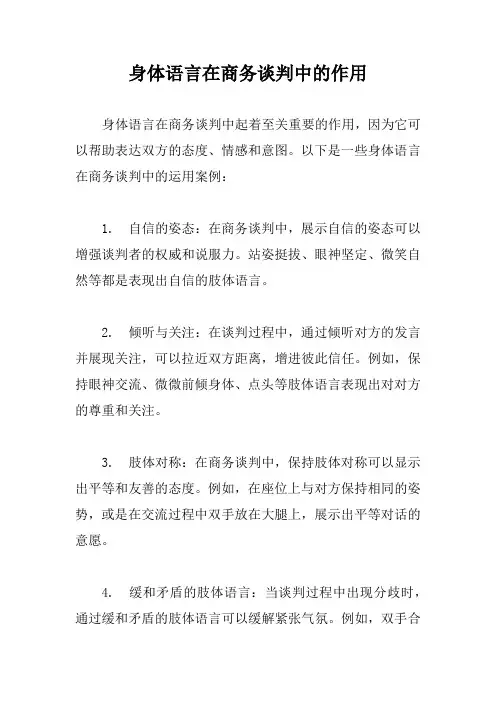
身体语言在商务谈判中的作用
身体语言在商务谈判中起着至关重要的作用,因为它可以帮助表达双方的态度、情感和意图。
以下是一些身体语言在商务谈判中的运用案例:
1. 自信的姿态:在商务谈判中,展示自信的姿态可以增强谈判者的权威和说服力。
站姿挺拔、眼神坚定、微笑自然等都是表现出自信的肢体语言。
2. 倾听与关注:在谈判过程中,通过倾听对方的发言并展现关注,可以拉近双方距离,增进彼此信任。
例如,保持眼神交流、微微前倾身体、点头等肢体语言表现出对对方的尊重和关注。
3. 肢体对称:在商务谈判中,保持肢体对称可以显示出平等和友善的态度。
例如,在座位上与对方保持相同的姿势,或是在交流过程中双手放在大腿上,展示出平等对话的意愿。
4. 缓和矛盾的肢体语言:当谈判过程中出现分歧时,通过缓和矛盾的肢体语言可以缓解紧张气氛。
例如,双手合
十表示诚意,或通过微笑和柔和的眼神表达歉意和理解。
5. 互补性肢体语言:在谈判中,采用互补性肢体语言可以加强沟通效果。
例如,对方头部向后仰,你可以向前探头;对方抱臂,你可以放下手臂,这种互补性动作有助于建立默契。
6. 运用空间:在商务谈判中,合理运用空间可以表达出不同的态度。
例如,主动靠近对方展示友好,或保持一定距离以显示尊重对方的个人空间。
7. 避免不良肢体语言:在谈判过程中,避免使用不良肢体语言,如交叉手臂、翻白眼等,这些动作可能会给对方留下不好的印象,影响谈判结果。
总之,在商务谈判中,恰当地运用身体语言可以提升谈判效果,增进双方沟通与信任。
了解并掌握身体语言的运用,对于谈判成功具有重要意义。
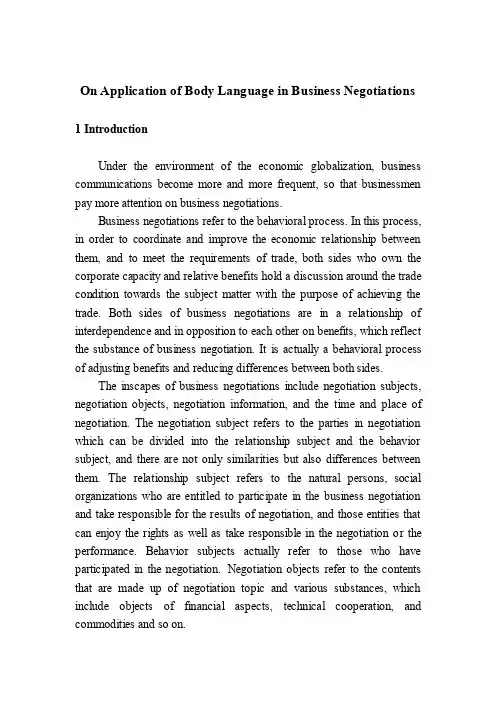
On Application of Body Language in Business Negotiations 1 IntroductionUnder the environment of the economic globalization, business communications become more and more frequent, so that businessmen pay more attention on business negotiations.Business negotiations refer to the behavioral process. In this process, in order to coordinate and improve the economic relationship between them, and to meet the requirements of trade, both sides who own the corporate capacity and relative benefits hold a discussion around the trade condition towards the subject matter with the purpose of achieving the trade. Both sides of business negotiations are in a relationship of interdependence and in opposition to each other on benefits, which reflect the substance of business negotiation. It is actually a behavioral process of adjusting benefits and reducing differences between both sides.The inscapes of business negotiations include negotiation subjects, negotiation objects, negotiation information, and the time and place of negotiation. The negotiation subject refers to the parties in negotiation which can be divided into the relationship subject and the behavior subject, and there are not only similarities but also differences between them. The relationship subject refers to the natural persons, social organizations who are entitled to participate in the business negotiation and take responsible for the results of negotiation, and those entities that can enjoy the rights as well as take responsible in the negotiation or the performance.Behavior subjects actually refer to those who have participated in the negotiation.Negotiation objects refer to the contents that are made up of negotiation topic and various substances, which include objects of financial aspects, technical cooperation, and commodities and so on.During the business negotiation, it is necessary to own great negotiation skills and negotiation ways for both parties, because the negotiation subjects are required to communicate and consult the information around the negotiation objects.A successful business negotiation requires that the negotiators know the principles of negotiations, relative laws and commercial businesses. On the other hand, it is also important to master the skills of negotiations—that is the individual language code of conduct and the ability of perception towards non-language behaviors (Zhang Lehui, Chang Qing, 2012:27). As the basic tool of communications, language plays a vital role in the international negotiations. However, language communication is not the only mean of communications. During the process of communications, non-language communication happens with language communication at the same time. Therefore, as one of the important part of non-language communications, body language can break language impediment and help people transmit the information more completely. The negotiators focus on body language because it is a significant part of business negotiation strategies. If the momentous function of language communication is ignored, the business negotiations will fail to be held successfully. Moreover, the reality and hard-to-camouflage are also vital factors which can influence the results in the process of negotiations. In order to make the business negotiation hold more successfully, it is indispensable to do a research on body language.However, the studies about body language in the international stage are mostly related to biology and criminology, and it rarely refers to the field of business negotiations. In international business negotiations, the negotiators need to make contact with different people from different countries with different cultures, so the phenomenon of cultural conflicts is very common. If it is hard to break the language impediment, body language is the best tool during the communications. Therefore, thepurpose of this paper is to study the performance forms of body language in business negotiations, in which the applications and functions of body language in business negotiations are emphatically analyzed. It can not only make it clear for negotiators to know the importance of body language in business negotiations, but also break the impediment of different languages to avoid cultural conflicts, and contribute to the success of the business negotiations.2 Main forms of Body LanguageTo declare the connection between body language and business negotiations more clearly, this part will make a brief descriptions of the concepts of body language. Only in case of that the forms and connotations of the body language can be clearly understood by negotiators. They will hold the tendency of negotiations in time.Body language is also called kinesics. The definition of body language is given by Oxford Advanced Learner’s English-Chinese Dictionary: Body language refers to the process of communicating what you are feeling or thinking by the way you place and move your body rather than by words. In other words, it means expressing the emotions through the body posture (Hornby, 2008:209).The Merriam Webster Dictionary: Body language refers to the gestures, actions and behaviors for communications of a person or an animal (Webster, 2001:155).From the explanations given by above dictionaries, it can be seen that body language is a non-verbal behavior which can convey the psychological activities hidden in the heart and expressed without languages.Body language has followed several major forms of expression.2.1 Transparent Head ActionsHead movements include nodding head, raising head and scratchinghead. These movements have different meanings under different cultural backgrounds (Li Wenying, 2011:119). Nodding head means ―yes‖ and shaking head means ―no‖ in China, England and America, while people use nodding head express ―no‖ and use shaking head mean ―yes‖ in some other countries. For example, it means ―yes‖ when Indians shake one side of the head from one side. But for some other people, it means ―yes‖ when nodding the head upward or down and ―no‖ when lean ing to one side.In America, people can shout ―Heads up‖ to remind others of taking care when it seems something dangerous to happen, and they will naturally raise their heads to look at them or look around. But raising heads means thinking hard in China.Movements like scratching heads occur when people are confused about something or try to recall someone or something. It also occurs when people are required to make a decision in dealing the problems. When you have no answers to the questions of others, you can scratch your head to express the idea that please give me some time to think and consider.2.2 Delicate Facial ExpressionsFace is called the organ of emotion, because we usually can read his or her feeling of heart through the facial expressions. Face provides the vital hints of our feelings to surrounding people.In China and other English speaking countries, it means friendly, approval, satisfaction, happiness and pleasure no matter it is smile or laughter (Wang Hui, 2009:76). When there are some guests at our home, we will welcome them with a smile, but Indians cry to show their welcomes. In African countries, laughing is used to express surprise, embarrassment and intolerant, so ―black laughter‖ in English stems from the description of laughter from African (Li Wenying, 2011:119).Sneering means insincere in North America and England, but scorn and ridicule in China (Li Wenying, 2011:119). Pulling one’s face meansunhappy both in North America and in China. Frowning means sad or disagree in North America and England but doubt and think deeply in China. Raising the eyebrows means surprise in North America but disagreement and worry in England.2.3 Exquisite Eye ContactZhang Wendi proposed that eyes are the window of heart. People often can see others’ psychological status and real thoughts through their eyes. And eyes are the most important parts which can perfectly provide other people some subtle messages among those body parts transferring information (Zhang Wendi, 2009:245). So eye contact plays a significant role in the social communication. Due to the difference in places, the feeling demands of the conversations and backgrounds, the eye contacts of people are different. For example, the accepted distances of eye contact among white people, in which people just glance at others and avoid direct eye contact, are 16-32 foots in American big cities. But in the small towns, people used to greet others by eye contacts even to strangers.The eye contacts between people during the conversation are different owing to the difference in social classes, ages, regions, races and countries. For instance, in America and most western countries, both parties hope that the other party to gaze at them rather than lower their head to pretend to be not seen in the communications, which would let others feel that the speaker is indifferent to the conversation and does not want to talk (Wang Hui, 2009:76). Especially in the public speech, it is required to look at the audience and make some eye contacts. If the speaker just lower his head to look at the speech draft and the eyes are indecisive, it will make the audiences feel that the speaker is timid and disrespectful. But in China, Japan and Mexico, the speaker and listener can’t keep looking at each other when they have conversation, because direct eye contacts means impolite. In Japan, people should look at the position of the prominent laryngeal rather than eyes during the conversation. In Arab countries, people should look steadily at others toshow that they are interested in the topic. In Puerto Rico, it is an honorific and obedient performance for nice girls not to look at the eyes of adults.2.4 Direct GestureGestures refer to a set of language system which is built by speech center using the positions and shapes of palms and fingers to express what you want to say (Chen Junsen, Fan Weiwei, 2000:205). Generally speaking, gestures in Southern Europe areas are most frequently and turgidly used like Italy, Spanish, and Greece, and the Western Europe countries have taken the second place in usages of gestures like Germany, England and Netherlands. However, gestures are almost never used to express any information in the Nordic countries which are far away.Thumbs-up has different meanings in different countries. It means agreement and satisfaction in North America, Great Britain and Russia, but offence in Iran, and rudeness in Australia. And it shows the praise for the good job of others in China and requests of hitchhiking in America and France. Gao Fei pointed that it expresses good, nice and well-done in England when someone uses thumbs-up sigh, but in Iran culture it means discontent and nasty (Gao Fei, 2010:146). Thumbs-down can mean not only disagreement but also not well in North America. However, it is a rude and impolite behavior in Hellenism.In America and most Europe countries, raising middle fingers means despising and disdaining which is an extremely rude behavior. But it has no special meaning in China and some Asian countries.The gesture of OK means great, everything goes well in China (Liu Baiyu, 2006:47), and agreement in North America and Germany but no value and zero in France and European countries, and money in Japan. In some conditions this gesture means the number of three in China.Using the fingers to tap temples gently means people are trying to think and meditate in China, Peru and African countries. But in Germany, Europe and North American countries, it is a representation for someone going crazy and insane.People will clench their fists when they are determined to do something in China, and it can also mean power. But it means anger in North America and Great Britain countries, and wretched appearance in Pakistan and Lebanon which is indelicate to make such a gesture in public.3Function of Body Language in Business NegotiationsThrough the brief descriptions mentioned above, it can know that body language have several forms, and it is of great importance to use and interpret body language correctly and understand the functions of body language in business negotiations. This part will analyze the functions of body language in business negotiations through some instances as follows.As a mixture of movement, posture, and tone of voice with a strong subconscious layer, body language, including head actions, facial expressions, eye contact and gestures reflects our feelings, thoughts and attitude towards the interlocutor so accurately that it can undermine our verbal discourse. This, corroborated with the statistic detail that over 70% of our communication is done nonverbally (Goman, 2008:35), places further emphasis on the importance of acquiring skills pertaining to this type of interaction in order to ensure efficient social and business relations.3.1 Reinforcement of Language ExpressionPeople will find that they can’t say everything on their mind when they communicate with others through language, and body language is needed at that time to make up for deficiencies of language. It is better to state your ideas with body language so that you can express your intentions more sufficiently and completely. Jiang Y ang put forward that body language can strengthen and replenish expression of verbal language as well as externalize the verbal information (Jiang Yang,2009:145). So sometimes it is not enough to express your own intentions only through language in business negotiations, body language is also needed.There is a business negotiation between an American company and a Chinese company. The Chinese main negotiator is required to suspend the negotiation because the quotation of the American is beyond the Chinese expectation. The American do not know what happened, but the American start to understand the intention of the rival when they found that the Chinese main negotiator start to wipe the glasses. The negotiation is ongoing after a short break, and finally the negotiation proved to be successful. It can see from this case that negotiator should not bring the pressure to the rival when he start to clean his glasses because this action imply that the rival is under consideration with hesitation, negotiator should give the rival enough time to consider and then the negotiation can continue when the rival put on his glasses again.3.2 Substitution of Language in Certain ConditionsIt will obtain a good effect by keeping silence and using body language when the expression of language is inopportune or cannot be understood by others during the negotiation. For example, the Empty Fort Strategy (Luo Guanzhong, 1979:823), which was a great success, is a full description of the irreplaceable uniqu eness of body language that doesn’t exist in language. In the Three Kingdoms Romance, facing with the situation that the city was besieged by Sima Yi, Zhuge Liang ordered his soldiers to open all the gates and set them dressed as ordinary people cleaning the streets at each gate. When all these preparations were complete, he sat down on the wall by one of the towers with his lute before him and a stick of incense burning. Seeing that Zhu was so calm and confident, Si retreated with his men with a belief that there must be an ambush in the city. Zhu made the overpowering enemy retreat without any word or loss. It cannot deny that his use of body language played an important role during the case. Analyzing the story in detail, Zhu seatedhimself on the wall of the tower, drinking and playing his lute, which was enough to manifest calmness in his mind. His unrestrained posture while playing the lute and the manner of his wanton drinking, both lead Si to associate his calmness and confidence with the strong army he had. He didn’t have much eye contact with Sima Y i, which won’t betray his trick. On the contrary, however, Si would feel confused and foul up his plan when seeing this. Zhu managed to deceive Si by taking advantage of body language, making Si believe in the ambush and retreat his troops, which, to some extent, as the saying goes, silence speaks volumes.Likewise, there are some examples in business negotiations. In June 1987, the factory director of the Primary Machine Tool Plant in Jinan had a negotiation with Karman Company which focuses on marketing machine tool in Los Angeles. Both parties reached an impasse when they negotiate with price. And Chinese party mastered the following information. America has put up tariff for Japan, Korean and Taiwan, so Taiwan Company refused to deliver goods, which led to failure in fulfill the contract between Karman Company and Taiwan Company. But Karman Company has entered into a supply contract with their client and the client needed goods urgently, which left Karman Company in a passive position. The Chinese party dealt with it calmly in later negotiation according to the information they have got. In negotiation, Karman Company offered price many times that under the Chinese party’s offering price, while the Chinese party did not response it and hinted that offering price is too low with their heads shaking. There was a long silence which put both parties an awkward position so that Karman Company got excited at last. The representative of Karman Company has compromised with the Chinese party in the end of negotiation. They purchased 150 machine tools from China on the basis of the price in purchase contract which proposed by the Chinese party. It is can be seen that it’s not wise to bring it up directly when the other party’s offering conditions cannot reach your expectant requirements. Instead, you canapply some negative body language to express your discontentment and keep silence properly, which make the other party hard to read your mind. As time goes by, the other party will get anxious. In order to reach cooperation they have no choice but to promise your requirements.3.3 Transfer of Psychological ImplicationA person’s emotions can be expressed through body language, that is to say, body language has the abili ty to intimate someone’s inner thoughts. In a face-to-face negotiation, negotiators will give out or accept large amounts of information by body, the information of which is more important than that of language (Liu Ting, 2011:138). Generally, the information, delivered unconsciously, can better reflect mental activities of the opposite (Cheng Zhiming, 1991:138).During an international negotiation between China and Britain, there came a divergence on the conditions, for China thought that the price proposed by Britain was too high. Both sides went through a fierce debate regarding the difference. To make the negotiation progress continuously, China asked for a suspension. After a rest, China proposed the final price, claiming that it would not give way any longer. The British side remained silence on the price. At the moment when people expected the negotiation’s rupture, Chinese main negotiator noticed that the British main negotiator’s left shoulder, hard and powerful,shook slightly, and then he knew the negotiation would be a success. Subsequently, the British side agreed to sign the contract. Through the case, it can testify that body language does possess suggestibility. Why did the slight shaking of British chief negotiator’s shoulder indicate the success from the perspective of the Chinese chief negotiator? Obviously, he would have kept on communicating with the opposite side instead of staying taciturnity and thinking, if the British chief negotiator had not agreed on the final price. The slight shaking of his shoulder just revealed that he had accepted China’s final price. Agreeing internally, his body no longer remained tense but relaxed. Therefore, in negotiation, besides noticing theopposite’s words, negotiators also need to watch out for their body language, which can soon convey other’s inner thoughts. Understanding the intimations conveyed by these body languages, negotiators will know exactly how to suit the remedy to the case. At the same time, negotiators should notice their own body language in case that these involuntary movements reveal their real emotion and thoughts.4 Application of Body Language in Business NegotiationsIt shows that during communication, only 35% of information can transmit through verbal communication, while information that convey through nonverbal communication which mainly refers to body language can reach 65% (Ross, 1970:15).In 1967, the pioneer of body language study, Albert Mehrabian, has found that in the influence which produced by an information there are 7% from languages which merely refer to words, 38% from sounds which include voice, tone and other sounds, and the rest 55% from voiceless body languages (Mehrabian, 1967:33).That is to say, most information convey through body language in the business negotiation process which needs face-to-face communication and continuous information transmission (Samovar, 1981:155).And the specific applications of body languages in business negotiation are in the following aspects.4.1 Efficient Convey of EyesightEyes are the window of heart. As negotiators’ part, it is eyes that mostly show the psychological activities of themselves or their opponents (Deng Nianli, 2008:233).In the process of negotiation, the negotiators need to gaze at eyes of each others, as it shows your seriousness, and others can feel your sincere attitude. At the same time, the length of the times of gazing at others is also important, and generally the listener should give more eyes on thespeaker. If the both parties are of the same gender in the negotiation, the negotiator should look attentively to each other from time to time to show their respects; if the relationships of both parties are close, they can look face to face for a lone time to close the distance of heart; and if the both parties are not of the same gender, it is improper to have their eyes on others for a long time because it may not only make others uneasy but also a rude action. In addition, it is not suitable to have indifferent, cynically, tired and vacillate eyes, because it is not only a impolite performance which shows no respect to others, but also do great damage to mutual communications and affect to the result of negotiation. If negotiators can use proper eyesight to look at each other from time to time in the negotiation, it can show the respect for others and indicate the interest about the topic, which can contribute to better ensuring the success of the negotiation.Confidence is the key factor in the negotiation. Don’t avoid each other’s eyes since it will ma ke others feel that you are lacking of confidence and experience which may let others look your side down and cannot maximize your interests and meet your requirements.Experienced business negotiator is good at catching the slight eyesight changes, gaining much valuable information from it, and perceiving the psychological changes of each other and the trend of the negotiation.4.2 Timely Exhibition of SmileSmiling can break the ice and help negotiation going smoothly when there comes to a deadlock (Li Fang, 2006:122).Generally speaking, smiling indicate a happy facial expression and quiet smile. It shows a mental well-being, and makes people calm and pleasure. Smiling is a show unintentionally of sincere inner, and it expresses a feeling of magnanimity and kindness. Smiling can show an intimate expression and effectively narrow the distance between each other, staying a good impression for the opposite, thus forming aharmonious communication atmosphere. So we can say that smile is lubricant in the interpersonal communication.Negotiators need to keep smile in the process of negotiation because it is a very important way in business negotiations. It can better convey the feeling, communicate and conquer rivals. In business negotiations, smile is regarded as the first communicative language by negotiators. If smile can be properly applied, negotiation will obtain good effects.Smiles are facial expressions that create a positive business environment by showing interest, excitement, empathy, or concern. Given their effectiveness, we should be aware of their negative impact if overused. Therefore, to gain and increase respect and attention, we should first establish our presence in a business context and, only then, smile. This approach will surely be perceived far more professional than entering a room giggling or ―all smiles‖(Dumbravă, Koronka, 2009: 253).Whether people can smile perfectly or not can show the abilities of negotiators that they can adapt atmosphere well and make negotiation go on well. People should give each other a smile at the first meeting, and then the constraint will be eliminated through smile (Liu Yinxia, 2009:223). Y ou can laugh when others offend you. If you do this, you can relieve the tension of rivals. If rivals make a mistake, a smile might help him. In a word, a just perfect smile can not only make ourselves relax, but can also provide convenience for rivals. Smile can remove the barriers and build the communication bridge between two parties, as well as feel each other’s attitudes and mental activities, even two parties’ thoughts, so as to promote successful negotiation.In negotiations, even if there are different opinions between both parties, the negotiators should always keep smile and do not change facial expressions.4.3 Correct Application of GesturesGestures are frequently used in business negotiations. And the mostcommon gesture is handshake.Handshakes are another important component of interpersonal encounters. In fact, it has become common knowledge that the few seconds of a handshake can be crucial for building a business relationship.A person who shakes hands by placing his hand onto the top is the so-called controller that is someone who wants to be in charge, which is to be kept in mind during any interaction. Moreover, the sandwich handshake, in which we use both hands to envelop the interlocutor’s hand, is not recommended as it is considered to invade their personal space.The general suggestion is to extend the full hand, in a reasonably strong grip, not only in fingers, which would be a sign of insecurity, or even impudence to the interlocutor, and to avoid, in any case, extending a wet hand, no matter what the reasons of the moist are. Since this is very unpleasant for the receiver, it is strongly appropriate to wipe our right hand before handshake.Negotiators should master the standard handshake gestures and understand basic handshake etiquette. For example, when the high positions shake hands with the lowers, it is appropriate that the high positions should stretch out his hand firstly , hold the person’s hand firmly and shake three times maximum. The elements of an effective handshake also included maintain constant eye contact and radiate positive aura (Bjorseth, 1994: 48). And then this first meeting will leave a very good impression to rivals.In the process of business negotiations, in order to make the rivals clearly understood about the content of the negotiations, the negotiators will properly use gesture to supplement the content of the negotiations. But gestures under different cultural background are not the same as well as the specific meaning of them. In the circumstance that if negotiators themselves do not fully understand and grasp the use of gestures, it would cause misunderstanding to became boring. Before the negotiations, making a thorough understanding of each other’s culture enables to avoidoffending the rivals due to wrong gestures (Zhao Xiuhua, 2008:58). It is not the best way to use this kind of gesture with a finger pointing to the others, because it may bring the rivals antipathy, and meanwhile it is impolite to swing fist when they speaking.And in the process of negotiations, the emergence of some gestures can also expose each other’s ideas. People always wring their hands when they are nervous; On the contrary, when everything has been taken into consideration, their hands will be naturally in their lap; when someone makes up his mind, they would secretly fist or pat thighs, etc. Noticing the changes can help to grasp the negotiations toward the largest interests.4.4 Proper Adjustment of Body PosturesDeng Yanchang and Liu Runqing put forward that the body postures mainly refers to some different body position caused by physical movements which contain sitting, standing, going, walking and so on (Deng Y anchang, Liu Runqing, 1989:89). The body posture, also called body position, including setting posture and standing posture, is a basic quality that reflects whether people are well-educated or not. There is a saying goes for a long time that people should stand like a pine, sit like a bell and walk like wind .That is to say, that people should sit properly means the upper part of the body should erect naturally with knees together; standing like those pines which are still standing; while walks trippingly.Posture influences how people perceive you. Just as someone with great body posture sends nonverbal signals of energy, confidence, and health, a person with poor body posture seems uninterested, uncertain, or insecure—not the impression that any of us want to project to our bosses, customers, and colleagues.Body posture is one of the first things that people notice about their interlocutor and, therefore, an important contributor to first impression. Thus, walking and standing with, head up, shoulders back, conveys a message of self-confidence and balance, automatically commanding。


浅谈肢体语言在国际商务谈判中的有效运用内容摘要:肢体语言对推动国际商务谈判的进程有着重要作用。
在西方发达国家,早已经有人将肢体语言与商务谈判结合起来研究,甚至成为专门的学科。
本文旨通过对国际商务谈判中肢体语言运用的基本原则及常见的几个部位的肢体语言所传达的信息进行分析,从而实现肢体语言在国际商务谈判中的有效运用,为中国企业在未来的国际商务谈判中,提高谈判效率、争取更多的主动权和胜算。
关键词:肢体语言;国际商务谈判;有效运用一、肢体语言的定义肢体语言(body language)又称身体语言,是指通过头、眼、颈、手、肘、臂、身、胯、足等人体部位的协调活动来传达人物的思想,形象地借以表情达意的一种沟通方式。
广义言之,肢体语言也包括前述之面部表情在内;狭义言之,肢体语言只包括身体与四肢所表达的意义(注1)。
到目前为止,我们所知道的最早的肢体语言的研究者,应该是19世纪的查尔斯•达尔文。
到了20世纪50年代,阿尔伯特•麦拉宾开始进行系统化的肢体语言研究,并提出了著名的“麦拉宾法则”也称为“7─38─55法则”:我们评断一个人,根据语言得到的讯息(谈话内容、言词的意义)占7%,从听觉得到的讯息(声音大小、语调等)占38%,透过视觉得到的讯息(外在、表情、动作、态度等)占55%。
在某种特殊情况下,肢体语言不但可以单独使用,甚至还可以表达出自然有声语言难以表达的思想感情,直接代替自然有声语言(注2)。
语言是理性的行为是经过加工之后的信息,而肢体的这些动作是无意识的或下意识的,更能直观、迅速地暴露谈判对方最真实或者更深层次的想法。
所以,在商务谈判中,我们在听其言的同时,更重要的是要观其行,从肢体语言的角度,分析和判断对方的心理变化。
同时,根据这些变化,有意识地调整谈判的方法,使谈判向有利于自己的方向发展。
二、肢体语言在国际商务谈判中有效运用的总体原则龙永图说,谈判是双方相互进行有原则、有底线的妥协,并最终实现双赢的过程。

![[分享]论肢体语言在商务活动中的作用](https://uimg.taocdn.com/d0988cd4db38376baf1ffc4ffe4733687f21fc40.webp)
肢体语言在商务谈判中的作用众所周知,随着经济全球化的发展,跨国贸易的频繁,商务谈判也就自然成了我们工作中必不可少的部分。
然而谈判必然要涉及沟通,沟通又包括语言与非语言沟通。
我们都了解语言沟通的魅力,但是由于各国在政治,历史,风俗文化上的差异,我们不难发现作为非语言的肢体语言沟通在商务谈判中也起着尤为重要的作用。
一,所谓的商务谈判就是各个经济实体为了实现自身的经济利益和满足对方的需要,通过沟通、协商、妥协、合作、策略等各种方式,把可能的商机确定下来的活动过程。
那又何谓肢体语言呢?若在一场商务谈判活动开始,对方积极主动向你握手、点头、微笑,那么你也就会认为对方是热情、礼貌、真诚的。
若对方在谈判中表现的眉头深锁、咬唇、摇头,那么你就能感觉到可能对方对你的要求不满意或者有待考虑等等。
我们能从对方的细微动作中评判出他的内心活动,有时他的表现让你身处轻松或压力中,这就是无声语言的力量,即肢体语言。
由此我们可以定义肢体语言是指通过头、眼、颈、手、肘、足等人体部位的协调活动来传达人物的思想,形象地借以表情达意的一种沟通方式。
广义言之,肢体语言也包括前述之面部表情在内;狭义言之,肢体语言只包括身体与四肢所表达的意义。
二,语言的魅力在于它们都有属于自己独特的东西,肢体语言当然也不例外。
肢体语言的表现在无形中,好比如你愤怒时你会怒眼圆睁,你不懂时你会摇头,你难过时你会显得沉默忧郁,这些你可能不会用语言去表达出来,但是这些就足以看出你此时此刻的心情以及意识,故肢体语言的外在表达具备强有力的直观性。
其次,肢体语言是丰富多样的,它的丰富多样体现在不同场合的同一动作所表达的含义可能是有差别的,因为肢体语言存在情景性,好比拍桌子这个动作,同样是拍桌子,可能是“拍案而起”,表示怒不可遏:也可能是“拍案叫绝”,表示赞赏至极。
当然我们主要探讨的是在商务中的意义,那肢体语言的丰富性就主要呈现在谈判过程中了,在双方谈判中,我们会低头,眯着眼,向前倾,抬头挺胸,正视对方,咬嘴唇或点头等,这么多样的肢体语言要表达什么意思,我们暂且不去分析,就针对这些肢体活动也说明它够丰富,够多样,更何况对于不同人不同事呢。
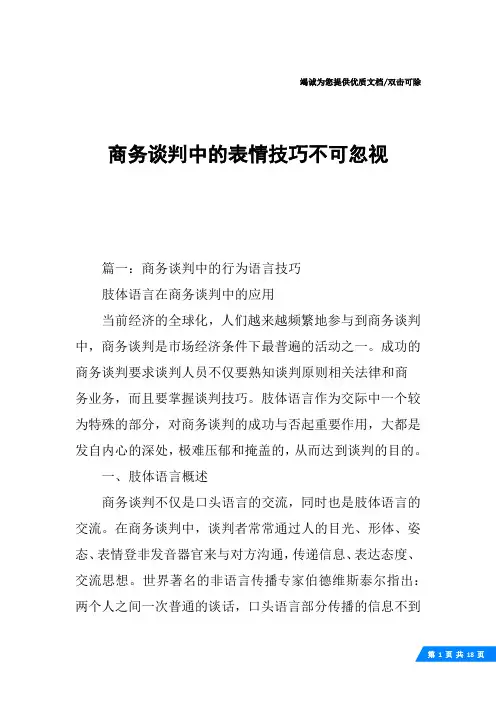
竭诚为您提供优质文档/双击可除商务谈判中的表情技巧不可忽视篇一:商务谈判中的行为语言技巧肢体语言在商务谈判中的应用当前经济的全球化,人们越来越频繁地参与到商务谈判中,商务谈判是市场经济条件下最普遍的活动之一。
成功的商务谈判要求谈判人员不仅要熟知谈判原则相关法律和商务业务,而且要掌握谈判技巧。
肢体语言作为交际中一个较为特殊的部分,对商务谈判的成功与否起重要作用,大都是发自内心的深处,极难压郁和掩盖的,从而达到谈判的目的。
一、肢体语言概述商务谈判不仅是口头语言的交流,同时也是肢体语言的交流。
在商务谈判中,谈判者常常通过人的目光、形体、姿态、表情登非发音器官来与对方沟通,传递信息、表达态度、交流思想。
世界著名的非语言传播专家伯德维斯泰尔指出:两个人之间一次普通的谈话,口头语言部分传播的信息不到35%,而非语言部分传播的信心达到65%。
因此,作为一个优秀的商务谈判者,除了具有丰富的有声语言技巧外,还应该具有丰富的行为语言技巧,在谈判过程中留意观察谈判对手的一颦一笑,一举一动,就有可能通过肢体语言窥视谈判对手的心理世界,把握谈判的情势,掌握谈判获胜的主动权。
在商务谈判中,肢体语言有着有声语言所无法替代的作用,但肢体语言必须有一定的连续性才能表达比较完整的意义,单独的一个动作难以传递丰富、复杂、完整的意义。
二、肢体语言的观察学会观察是运用肢体语言的前提,因此只有留心观察才能学会运用。
有一种比较好的学习观察方法,就是通过摄像机提供具体生动的素材,并在专业人员或有丰富谈判经验人员的帮助或提示下进行分析,也可以在自然条件下直接观察他人运用的各种行为语言,分析肢体语言的意思。
(一)面部表情1.目光语。
“眼睛是心灵的窗户”道出了眼睛具有反映内心世界的功能,通过眼视的方向、方位不同,产生不同的眼神,传达和表达不同的信息。
在谈判过程中,谈判组员之间可能会相互使眼色,这样,谈判者就必须注意眼睛对信息传递的观察和利用,而来自不同文化背景国家的人在交流时,注视对方眼睛的时间是不同的。
商务谈判中的肢体语言谈判是沟通,但并不一定是口头的。
事实上,眼神、手势或姿势能比言语传达的信息。
因此,留意并研究对手的身体语言所传达的有用信息,是有价值且有助于你谈判成功的。
下面店铺整理了商务谈判中的肢体语言的相关知识,供你阅读参考。
商务谈判中的肢体语言抽烟斗者抽烟斗者通常运用烟斗做为谈判的支持物。
对付这类对手的策略是,不要和烟斗抢着吸引抽烟斗者的注意。
例如,抽烟斗者伸手取火柴点烟时,这是你应停止谈话的线索。
等他点好烟开始吞云吐雾时,你再继续你的谈话。
如果你能很有技巧地去除此支持物,对你是有利的。
最容易的方法是注视烟斗。
所有烟斗终究会熄灭的,必须暂时放在烟灰缸或烟斗架上,在对方有重新拿起烟斗的冲动之前,给他一页数字、一本小册子,或任何能令他参与你的谈话的东西。
擦眼镜者你的对手在摘他的眼镜,开始擦拭时,这是适当停止的线索。
因为擦拭眼镜是擦拭者正在仔细考虑某一论点的信号。
所以,当擦拭开始时,不要再施加压力,让你的对手有足够时间考虑,等眼镜再挂上鼻梁时,再重新谈判。
松懈的对手有些人精神松懈。
不好好坐直、不够专注、一副垂头丧气的样子。
松懈并没有什么不好,问题是,如果意见的沟通过于不精确,会阻扰谈判的进行。
使对手紧张、严肃一点的好方法,是用眼神的接触。
你要谈判另一要点时,运用眼神接触并确定你的对手是否同意,不管是如何松懈的人,几乎都会对眼神接触有所反应的。
紧张大师有些人对面对面的谈判有恐惧感。
很明显的神经紧张、焦躁不安、甚至身子僵直。
他们的谈话过于僵硬、不自然。
此时你能做的是,放松对手的心情,让他有宾至如归的感觉。
慌张不安常发生于没有什么商业背景的人。
他们身处异地,不知道会发生什么事。
你可以建议比较舒适的座位安排,或者采取主动,松解你的领带,卷起你的袖子,来表示一切会很舒适轻松的。
有些人太紧张了,结果如果你不小心的话,他们会让你也开始紧张不安。
千万不要令这种事发生。
记住,没人想紧张、焦躁。
每个人都想拥有舒适愉快的感觉,所以如果你能消除对手的紧张不安,他会觉得好一点,对你心怀感激,这有助于谈判的成功。
摘要:身体语言作为一种言语交际中的语用策略,在国际商务谈判中发挥着重要意义。
本文从脸部表情、手部动作、姿态动作等方面分析身体语言在商务谈判中表达的信息,它能提高谈判人员的技≯,促进谈判的效率和成功率。
身体语言已成为赢取商务谈判的新的研究对象。
关键词:身体语言;国际商务谈判;心理学应用一、身体语言概述身体语言是指非语言性的身体符号,包括眼神与面部表情、身体运动与触摸、姿势、身体间的空间距离等,是除语言表达外另一种重要的沟通方式。
早在19世纪,查尔斯·达尔文已经开始了关于面部表情与肢体语言的研究;20世纪50年代,研究肢体语言的先锋人物阿尔伯特·麦拉宾发现:一条信息所产生的全部影响力中7%来自于语言(仅指文字,38%来自于声音(其中包括语音、音调以及其他声音,剩下的55%则全部来自于无声的肢体语言;人类学家雷·博威斯特(RayBirdwhistel1发现,在一次面对面的交流中,语言所传递的信息量在总信息量中所占的份额还不到35%,剩下的超过65%的信息都是通过非语言交流方式完成的。
?人们说话时总会运用一系列的动作来配合自己的谈话,相比语言的有意识,这些动作是无意识的,更能体现说话人的真实想法,因此,我们不仅要听其言,更要观其行,通过观察对方的言谈举止,捕捉其内心活动的蛛丝马迹;也可以从对方的姿态神情中探究其心理因素。
运用看的技巧,不仅可以判断对方的思想变化,决定本方对策,同时还可以有目的地运用语言传达信息,使谈判向有利于自己的方向发展。
二、身体语言在商务谈判情境下的运用依据谈判是双方对涉及切身权益的有待解决的问题进行充分交换意见和反复磋商,以寻求解决的途径,最后达成协议的合作过程。
谈判双方都有自己的需要,双方是带着这种既统一又矛盾的需要和目的来参加谈判的。
它不应是一方无止境地满足自己的利益,也不应是一方无条件地妥协。
谈判双方需要让步、妥协,但也有自己的底线。
可以说,为使自己达到利益最大化,双方都在不断试探着对方的底线,并竭力掩饰着自己的底线。
最新英语专业全英原创毕业论文,都是近期写作1 论苔丝悲剧的根源2 论《呼啸山庄》中的叙述技巧3 中英植物词语隐喻的文化对比4 对高中生英语听力自我效能感的调查和分析5 从英汉动物成语比较中英文化差异6 目的论视角下新闻标题汉译英研究7 从《少年派的奇幻漂流》看人性的两面性及自我斗争8 评《傲慢与偏见》中卢卡斯小姐9 英语语言中的性别歧视10 从保罗的恋母情结角度分析劳伦斯的《儿子与情人》11 论莱辛作品《又来了,爱情》中妇女失爱的原因12 海明威“冰山原理”在《永别了,武器》中的应用及对写作的指导意义13 《红字》中替罪羊形象的分析14 浅谈中外记者招待会中口译者的跨文化意识15 从关联理论角度分析《绝望主妇》中话语标记语I mean16 Humor and Violation of the Cooperative Principle17 析华兹华斯诗歌中的人与自然18 英文歌曲在提高英语专业学生口语能力方面的作用19 英语委婉语的构成与应用20 对比研究中西文化中的委婉语21 从《朗读者》中汉娜的形象论道德盲视现象22 安妮•赖斯《夜访吸血鬼》中吸血鬼形象研究23 Translation of Tourism English in a Cross-Cultral Perspective24 从功能翻译理论看电影《功夫熊猫》的字幕翻译25 A comparison of values of money between Scarlett and Gatsby26 天才的悲剧人生——论杰克伦敦的自传体小说《马丁伊登》27 约翰逊词典编纂特色探析28 精神危机下的自我救赎--对索尔贝娄《赫索格》中社会异化与身份认同的解读29 功能对等理论视角下李白诗歌中意象的英译30 从跨文化角度看电影标题汉译英31 《查泰莱夫人的情人》中的重生32 由中国的圣诞节“热”来看中美文化的冲突及融合33 《哈克贝利•芬恩历险记》中对自由的追寻34 《乞力马扎罗山上的雪》中的生与死35 中西饮食文化差异36 论中西饮食文化的差异37 On the Narrative Arts of Hemingway's Short Stories----A Case Study of"A Clean Well-lighted Place"38 探析《夜访吸血鬼》中的孤独39 性格和命运--《小妇人》中四姐妹分析40 商务谈判中的礼貌策略研究41 关于商务英语教材编写的几点思考--基于教材特点的比较分析42 从模因论角度研究中文新闻标题中的流行语43 《简•爱》的简和《德伯家的苔丝》的苔丝的比较研究44 商务英语中的缩略词研究45 从功能对等的角度分析《红楼梦》中的习语翻译46 《了不起的盖茨比》中乔丹•贝克的人物分析47 网络流行语翻译评析——“神马都是浮云”个案分析48 中国英语学习者道歉言语行为的中介语石化现象49 A Comparison of the English Color Terms50 An Analysis of the Feminism in The Scarlet Letter51 从《一间自己的房间》分析弗吉尼亚•伍尔夫的女性主义思想52 外贸合同中介词的用法与翻译53 Domestication and Foreignization in Idioms Translation54 矛盾的女性主义观—读乔治.艾略特的《弗罗斯河上的磨房》55 孤独的灵魂—简评《月亮和六便士》中的思特克兰德56 从华裔女性文学看东西方女性主义的发展与融合——以华裔女作家林湄及其作品《天望》为例57 生与死的抗争——《厄舍古厦的倒塌》主题解读58 英语委婉语及其翻译59 从《印度之行》看福斯特的人文主义思想观60 哥特元素在《宠儿》中的运用61 英语委婉语:礼貌视角下的有意不合作62 中西方餐桌礼仪的文化对比分析63 从关联翻译理论看《圣经》汉译过程中的关联缺失64 《欢乐之家》中丽莉追求婚姻时的自我矛盾65 研究网络语言的特点,影响以及其规范性66 对《汤姆叔叔的小屋》中人物的圣经原型解读67 An Analy sis of Gilmore’s American Existentialism in The Executioner’s Song68 The Countermeasures of Chinese Companies Facing Anti-dumping69 浅析《小妇人》中乔的女性意识及其成长过程70 解读《献给艾米丽的一朵玫瑰花》中“玫瑰”的象征意义71 An Analysis of American and Chinese Culture in Kung Fu Panda72 从中西思维方式的差异看《梦》及其英译本中主语的确定73 英国海洋文化对英语习语的影响74 从目的论角度比较研究《彼得•潘》两个中文译本75 文化负迁移对翻译的影响76 《乱世佳人》女主人公斯嘉丽的性格分析77 民族文化差异与广告语言创意78 A Study of Pragmatic Functions of Fuzzy Language in English Advertisements79 中西方餐具文化对比研究—以筷子和刀叉为例80 目的论下英语广告仿拟格的汉译81 埃尔文•布鲁克斯•怀特《精灵鼠小弟》中的动物形象分析82 简析译者文化背景对其处理习语翻译的影响--《水浒传》赛珍珠译本中的习语翻译83 《小妇人》中的性别语言差异分析84 从文化角度谈商标的中英互译85 杰克•伦敦《野性的呼唤》的生态解读86 论女性主义对翻译标准的影响87 英汉”黑色”的隐喻的对比研究88 从批评话语分析角度看奥巴马就职演说中的感召力89 小组合作在高中英语阅读教学中的运用90 论电影片名翻译的“忠实性”91 浅谈我国服装行业的网络营销92 《呼啸山庄》中男主人公希斯克利夫复仇动机分析93 The Environmental Influence on Emily Brontë and "Wuthering Heights"94 关联理论关照下文化缺省现象及其翻译应对策略95 A Comparison of the English Color Terms96 Judy’s Double Character in Daddy-Long-Legs97 从“米兰达”的人物形象看凯瑟琳安波特的女性观98 Western and Chinese Marriage Differences in Cross-cultural Communication99 国际商务合同的用词特点及翻译100 论古希腊悲剧中的命运观101102 A Preliminary Study on Christianity103 目的论指导下中国特色词的英译104 小学英语课堂提问策略研究105 从传统消费观念看中美文化差异106 On the Spiritual Independence under the force of Public Opinion in To Kill a Mockingbird 107 浅析跟单信用证软条款及其防范措施108 在孤独中寻找自我——析《没有指针的钟》J.T.马龙的救赎109 英式英语和美式英语中的词汇差异110 《嘉莉妹妹》之悲剧性——基于嘉莉与赫斯特伍德的比较111 [毕业论文](经贸英语系毕业论文)草根营销以及策略112 从爱情三元素理论看《了不起的盖茨比》中人物的爱情模式113 从小说《麦田里的守望者》的主人公看当代大学毕业生的迷惘114 《洛丽塔》主题与艺术技巧之探析115 英语新闻标题的前景化116 A Study of Children Images in Huck Finn and Tom Sawyer117 论“冰山原则”在《白象似的群山》中的应用118 英语歌曲在英语教学中的应用119 翻译腔成因浅探120 浅谈中国古词的色彩美在英语中的重现121 怎样提高非英语专业学生的阅读理解122 动物•荒原•牧场——生态视野下科马克•麦卡锡的《边疆三部曲》123 广告中的熟语模因探析124 论简爱与凯瑟琳性格与命运之异同125 浅议女性哥特主义在《暮光之城》中的体现126 A Study on Chinglish of EFL Learners in Junior High Schools in China127 试析《啊,拓荒者》中的生态伦理观128 南方时代变迁中的胜利者与失败者——《飘》中主要角色的性格与命运对比129 英汉动物习语的文化差异及其翻译策略130 论交际法在初中英语教学中的运用131 米字旗下的荣耀与忐忑——论维多利亚时代英国人的社会价值观132 中英日委婉语语言特征133 英汉形状类量词的隐喻认知分析134 英汉动物习语对比研究135 英汉俚语特色对比研究136 试析爱丽丝沃克作品中的女性主义观点——以《紫色》为例137 解读海明威的性属观138 中西方婚礼礼服颜色的对比研究139 语境对法律英语翻译的影响140 An Embodiment of Virtue--- A Moral Insight into the Image of Tess141 模糊语言在商务英语谈判中的语用功能142 A Contrastive Study of English and Chinese Gratitude Expressions143 跨文化交际中的体态语144 Cooperative Principle in Business Letters145 从禁忌语看中西文化差异146 维多利亚时期的艺术对文学的影响——以白衣女人为例147 小说《鲁滨逊漂流记》中的精神力量分析148 国际快递公司的本土化战略149 论后现代写作技巧在白雪公主中的运用150 从《献给艾米丽的玫瑰》看福克纳小说中贵族的没落151 Pronunciation Problems in English Language Teaching152 易卜生戏剧《培尔•金特》中培尔•金特的宗教救赎之路153 Jane Austen’s Opinion towards Marriage in Pride and Prejudice154155 对《儿子与情人》中的自然环境描写的研究156 论《永别了,武器》的写作风格157 英汉味觉词“酸甜苦辣”的比较分析158 交替传译中笔记的作用159 理解美式幽默的初步分析160 伊丽莎白班内特和姚木兰的比较研究161 字母拼读法在小学英语语音教学中的应用162 浅谈多媒体在中学英语教学中的应用163 美国俚语的文化及特征164 语音歧义和语义歧义的语言学分析165 英汉色彩词的语用对比研究166 对话中语用意义的理论视角167 论国际商务中的跨文化有效沟通168 麦都思眼中的中国宗教形象169 大学生上网调查170 浅析小学汉英双语教学171 The Use of Body Language in Teaching172 汽车广告英语的语言特点及其翻译173 在概念整合理论下探讨英语复合词教学174 希腊罗马神话典故成语英汉翻译评析175 American Individualism and Its Reflection in the Film Erin Brockovich176 写作教学中的范文教学177 论《简爱》对当代女性爱情观的启示178 The Pervasive Agitation of Humbert in Lolita179 我国高中生英语学习动机研究180 从《太阳照常升起》分析美国一战后的消费道德观181 目的论视角下公益广告的翻译182 英文电影中俚语的翻译策略183 从"龙"一词的文化内涵看汉英文化的差异184 A Comparison of the English Color Terms185 从宗教建筑看中西文化差异186 从电影《弱点》看美国的家庭教育187 论英汉成语翻译188 热情的侦探福尔摩斯和他的影响189 浅析中英恭维语190 浅析小说《傲慢与偏见》中的反讽艺术191 肢体语言在商务谈判中的应用与作用192 英语财经报道中的词汇衔接研究193 The Unique Characteristics of Edgar Allen Poe’s Gothic Stories194 The Rose in the “Heights”—An Analysis on Catherine’s Personality in Wuthering Heights 195 从广交会现场洽谈角度论英语委婉语在国际商务谈判中的功能与应用196 新课标下初中英语教师角色转变的研究197 论《白鲸》主角的悲剧实质198 关于照料母婴的市场分析199 从心理分析的角度探索《马贩子的女儿》中主要人物的心理现象200 从译者的读者意识看童话英汉翻译。
商务谈判肢体语言商务谈判肢体语言技巧1、不让对方“接近”,可提高你的气势据说在约翰,肯尼迪就任总统已经胜券在握时,他的顾问们和他保持了比之前更远的距离,对他表示了比之前更高的敬意。
因此,仅凭加大和对方之间的空间距离,就能表现出你的气势。
如果你是主任或经理,地位就和其他普通的职员不同,你的办公桌会大很多。
地位和桌子的大小着密切的关系。
为什么职位越高,桌子就会越大呢?这是为了增大和下属的距离。
通过设置一张隔开两人的桌子,无言地传达了“不能接近我”的信息。
根据在美国海军中进行的调查得知,两个正在谈话的人的地位差别越大,自然而然,两人之间的距离就越大。
如果最初讲话的是部下的话,这个倾向会更加明显。
不让别人接近你,就能增强你的气势。
这个谈判技巧被称做“空间利用”。
如果对方对你的话置若罔闻,不妨故意增大与他的距离。
因为远的距离表示你能够严格控制对方,可以在心理上起到贬低对方的作用。
当你和对方一起入座时,如果你想对他施加压力、迫其决断,就把椅子向后拖一拖。
通过增大和对方的距离,向对方施加压力,告诉对方“我不会给你更多的时间了”。
在谈判中,你可以装着想伸伸脚,很自然地把椅子往后挪一点。
另外,你也可以在中途休息后回到座位时,故意把椅子往后拉一点,这也是一个好办法。
从某种程度上说,如果你能够随心所欲地控制与对方在空间上的距离,你就能自如地控制对方的心理。
即使你和对方并肩而坐,也可以运用这个技巧。
这时虽然不可能通过坐得远一点来增大距离,但可以在你和对方之间设置某种屏障(专业术语称做“定位掩护”)。
比如,把包或上衣放在你和对方之间。
这样做的话,就巧妙地暗示对方“不要再接近我”,营造了不让对方接近你的气氛。
反之,如果对方想在你和他之间设置屏障时,你要阻止他的行为,拿掉他的屏障,这也是谈判中的有效战术。
商务谈判肢体语言技巧2、“模仿”对方的姿势一一镜子连环效果在心理学上,两个以上的人做同一个姿势叫做“镜子连环”。
例如,当一个人把胳膊抱在胸前,另一个人也把胳膊抱在胸前;一个人靠在墙上,另一个人也跟着靠到墙上。
非言语交际在国际商务谈判中的应用非言语交际是指通过行为、身体语言和表情等方式进行的交流和信息传递。
在国际商务谈判中,非言语交际起着至关重要的作用,它可以帮助双方理解对方的意图、建立信任、化解矛盾以及促进合作。
本文将就非言语交际在国际商务谈判中的应用进行讨论。
非言语交际可以帮助双方理解对方的意图。
在国际商务谈判中,双方往往使用不同的语言,语言障碍可能成为沟通的障碍。
此时,通过身体语言和表情来传递信息就显得尤为重要。
举个例子,当一方听到对方的提议时,他的眉头紧锁、嘴角微微上扬,这种肢体语言往往会让对方明白他的态度是拒绝或者不满意,进而可以更好地进行谈判。
非言语交际可以帮助建立信任。
在国际商务谈判中,双方往往是陌生人,彼此之间缺乏信任,这时非言语交际就起到了很重要的作用。
通过微笑、握手等非言语行为,可以打破陌生感,营造友好的氛围,从而建立起双方的信任。
在谈判过程中,双方的真诚、诚信等通过非言语交际传递出来,也会对信任的建立起到积极的作用。
非言语交际可以帮助化解矛盾。
在国际商务谈判中,双方可能会出现分歧和矛盾,如果仅仅通过语言来表达自己的观点和立场,很容易产生误解和冲突。
通过身体语言和表情来表达自己的情感和态度,有助于传递更准确的信息,避免产生误解和冲突,从而更好地化解矛盾。
非言语交际可以促进合作。
在国际商务谈判中,双方谈判的目的是达成合作协议,实现互利共赢。
通过非言语交际,双方可以更好地理解对方的意图和需求,进而更好地协调各自的利益,达成合作的共识。
当一方提到合作的机会时,他的脸上会流露出兴奋和期待的表情,这种表情往往会激发对方的积极性,从而更有可能达成合作协议。
发言中的肢体语言和表情的重要性尊敬的各位听众们,非常荣幸能够在这个重要的场合向大家发表主题为“发言中的肢体语言和表情的重要性”的演讲。
今天,我想与大家分享一些关于肢体语言和表情的重要性,以及如何利用它们改善我们的沟通和交流能力。
首先,让我们来看一下肢体语言和表情在我们日常生活中所起的作用。
尽管我们经常倾向于用言语表达自己的意见和情感,但是事实上,肢体语言和表情却更能够传达真实的意图和情感。
根据一项研究表明,当进行非言语交流时,只有7%的信息是通过语言传达的,而93%的信息则通过肢体语言、表情和声音的方式传达。
这证明了肢体语言和表情在沟通中所起到的关键性作用。
其次,肢体语言和表情的使用可以增强我们的说服力。
当我们发表演讲或者进行商务谈判时,我们经常需要说服他人接受我们的观点或提议。
在这种情况下,积极、自信和灵活运用肢体语言和表情会让我们更具有说服力。
研究表明,与仅使用语言相比,有多种形式的肢体语言和表情的使用可以使我们的观点更加令人信服和可信。
不仅如此,肢体语言和表情还可以帮助我们建立良好的人际关系。
在交流中,与对方建立情感联系的能力是非常重要的。
通过运用适当的肢体语言和表情,我们可以传达出友善、关怀和支持的信息,从而促进与他人的良好互动。
此外,肢体语言和表情还可以帮助我们更好地理解他人的情感和意图,从而增强沟通的效果。
然而,要真正利用肢体语言和表情的力量,我们需要注意一些关键的要素。
首先,我们需要保持身体的姿势端正和自信。
一个自信、笔直的身姿会让人们对我们的话更加信任。
此外,眼神接触也是非常重要的。
通过保持眼神接触,我们可以表达出对对方的关注和尊重。
同时,我们还要注重手势的使用。
适当的手势可以帮助我们更精确地表达意思,增加沟通的清晰度。
此外,在运用肢体语言和表情时,我们需要注意适度。
过度夸张或不自然的肢体语言和表情可能会给人留下不真实的印象,降低我们的可信度。
因此,我们应该通过练习和反思,逐渐发展出适合自己的肢体语言和表情风格。
浅谈肢体在商务谈判中的作用写作提纲一、绪论由于当前经济全球化,人们越来越频繁地参与到商务谈判中,商务谈判是市场经济条件下最普通的活动之一。
成功的商务谈判不仅要求谈判人员熟知谈判原则、相关法律及商务业务,而且要掌握谈判技巧。
肢体语言作为一种语言交际策略,在国际商务谈判中也有着重要的作用。
本文从肢体语言的特点着手,旨在突出肢体语言在商务谈判中的作用。
二、本论(一)肢体语言的概念及特点1.肢体语言的概念2.肢体语言的特点(二)肢体语言在商务谈判中的作用1.增强有声语言的表达力2.具有暗示性3.能迅速传递、反馈信息,增加互动性(三)肢体语言在商务谈判中的运用1.上肢动作语言信息2.下肢动作语言信息3.腹部动作语言信息三、结论随着商务交流的日益频繁,商务谈判也越来越受到商务人士的关注,肢体语言作为商务谈判中重要策略之一,也越来越被谈判者重视,肢体语言的真实和不易伪装在谈判过程中占主导地位,因此有效地利用商务谈判中的语言也是非常重要的。
浅谈肢体语言在商务谈判中的作用饶慕容【内容摘要】近年来,我国与世界各国的国际商务关系不断地发展变化,商务谈判在跨国商务和国际经济活动中日益频繁。
肢体语言作为商务谈判中重要的一部分,其作用也是非常重要的。
本文就肢体语言在商务谈判中的作用提出了在商务谈判中上肢动作、下肢动作和腹部动作三大肢体的语言信息,力求把握好肢体语言技巧,让商务谈判更好更顺利的进行。
【关键词】肢体语言商务谈判作用由于当前经济全球化,人们越来越频繁地参与到商务谈判中,商务谈判是市场经济条件下最普通的活动之一。
成功的商务谈判要求谈判人员不仅要熟知谈判原则、相关法律和商务业务,而且要掌握谈判技巧。
肢体语言作为商务谈判中重要的一部分,在商务谈判中也有着重要的作用。
本文就肢体语言的特点着手,旨在突出肢体语言在商务谈判中的作用。
一、肢体语言的概念及特点(一)肢体语言的概念肢体语言又称身体语言,是指非语言性的身体符号,包括眼神与面部表情、身体运动与触摸、姿势、身体间的空间距离等,是除语言表达外另一种重要的沟通方式广义言之,肢体语言也包括前述之面部表情在内;狭义言之,肢体语言只包括身体与四肢所表达的意义。
一般在面对面的交流中,语言所传递的信息量在总信息量中所占的份额还不到35%,剩下的超过65% 的信息都是通过非语言交流方式完成的。
人们说话时总会运用一系列的动作来配合自己的谈话,相比语言的有意识,这些动作是无意识的,更能体现说话人的真实想法,因此,我们不仅要听其言,更要观其行,通过观察对方的言谈举止,捕捉其内心活动的蛛丝马迹;也可以从对方的姿态神情中探究其心理因素。
运用看的技巧,不仅可以判断对方的思想变化,决定本方对策,同时还可以有目的地运用语言传达信息,使谈判向有利于自己的方向发展。
(二)肢体语言的特点1.无意识性由肢体所展现的“语言”往往能将本人一些未说出口的东西显露出来。
当然,有时是有意识的,如演员的表演,有时则是无意识的,甚至是自己无法控制的。
在沟通过程中,一方面可用非语言的方式向对方发出信息。
如:不看对方,注视窗外,显然就等于告诉对方你宁可身在他处,根本不值得浪费时间在这个话题上。
又如,把身体前倾,也许表示“很感兴趣”,接受会谈的人因此受到鼓励,可能会做更进一步说明。
如我们与人谈话时,时而蹙额,时而摇头,时而摆动姿势,时而两腿交叉,我们多半并不自知。
心理学家提出如下假设:当你与人说真话的是,你的身体将与对方接近;当你与人说假话时,你的身体将离对方较远。
此一假设验证的结果发现:如果要求不同受试者,分别与别人陈述明知是编造的假设与正确的交实时,说假话的受试者会不自觉地与对方保持较远的距离,而且显得身体的后靠,肢体的语言活动较少,唯有面部笑容反而增多。
2.文化差异性在不同文化中,肢体语言的意义不完全相同,各名族有不同的非话语交际方式。
如当一个阿拉伯人同英国人谈话时,阿拉伯人按照自己的民族习惯认为站得近些表示友好,而英国人按照英国的习惯则认为保持适当的距离才合适。
因此,当阿拉伯人往前挪的同时英国人则往后退。
谈话结束时,两个人离原来站的地方可能相当远。
在这个例子里,双方的距离是关键。
不同的民族在谈话时,对双方保持多大的距离才合适有不同的看法。
根据研究,据说在美国进行社交或公务谈话时,有四种距离表示四种不同情况:关系亲密,私人交往,一般社交,公共场合。
交谈双方关系亲密,那么身体的距离从直接接触到相距约45厘米之间,这种距离适于双方关系最为亲密的场合,比如谈夫妻关系、朋友、熟人或亲戚之间个人交谈,一般的相距45-80厘米为宜。
在进行一般社交活动时,交谈双方相距1.30米至3米;在工作或办公事时,在大型社交聚会上,交谈者一般保持1.30米至2米的距离。
在公共场合,交谈着之间相距更远,如在公共场所演说,教师在堂上讲课,他们同听众距离很远,多数讲英语的人,不喜欢人们离得太近,当然,离得太远也有些别扭,离得太近会使人感到不舒服,除非另有原因,如表示喜爱或鼓励对方与自己的亲近等。
在英国国家里,一般的朋友和熟人之间的交谈时,避免身体任何部位与对方接触,即使仅仅触摸一下也可能引起不良的反应。
如果一方无意触摸对方一下,他(她)一般会说sorry;oh,I’m sorry;Excuse me等表示“对不起”的道歉语。
美国人坐着喜欢架起腿的时候习惯于呈平面的“4”字行,而我们中国人却往往是一条腿压着另一条大腿。
在第二次世界大战期间,德国逮捕的美国情报员,多都是因为他们用右手拿叉子吃东西,有严格训练成欧洲人用叉子吃东西的方式,而露出马脚。
如果他们不知道美国人的“4”行架腿习惯,那么德国将会有一大批美国卧底。
3.真切性与直观性当人们看到了诱人动心的事物时,他的瞳孔就会放大。
当一个集邮迷得到一枚梦寐以求的珍贵的邮票时,当一个古董收藏家搜集到唐宋的精品时,他们的瞳孔都会比往常的放大许多。
在牌桌上,当发现对手拿起牌来眼睛发亮的时候,就能断定他得到一副好牌。
英国人心理学家阿盖依尔等人的研究表明,当语言与非语言信号所代表的意义不一样时,人们更相信非语言信号所代表的意义。
由于语言信息受理性意识的控制,容易作假;肢体语言则不同,肢体语言大都是发自内心深处,极难压制和掩盖的。
有声语言直接诉诸于人的听觉器官,不具有视觉的形象的感性;而肢体语言则不同,它的灵活性多变的表情动作、体姿、构成一定的人体图像来表情达意,交流信息,直接诉诸于人的视觉器官,具有形象直观的特点。
如形容物体的大小,用手势来比划,对事物表示赞成或反对,采用点头或摇头的方式等,就具有鲜明的形象直观性。
如果一个人看起来向左(他们离开你的右边),这意味着他们往往说真话,都在努力把你文字放在一起。
如果他们正在寻找到右侧(左侧的权利)的一些心理学家和辅导员认为,这就意味着他们在说谎,并试图等待时机的时间去思考一个合适的谎言继续。
一、肢体语言在商务谈判中的作用(一)增强有声语言的表达力人们运用语言进行思想沟通和情感的表达时,往往有词不达意的感觉,因此需要借助非语言行为进行帮助,或弥补语言的局限,或对言辞的内容加以强调,使自己的意图得到更充分,更完善和更准确的表达。
例如,当一个陌生人向你询路时,你也会一边说一边用于指向自己所说的方向的帮助对方更好的确认道路方向,这样便做到有效的信息沟通。
如,客户向推销员陈述拒绝的理由时,他们会将自己的手掌暴露于对方的视线之内,除了陈述理由,还通常会做出一些手部动作。
在国际商务谈判中,非语言增强有声语言表达力也非常重要,让我们看以下的例子:一个美国公司和一个中国公司在谈判时,美方报价和中方实际随期待的价格相差比较大,这时,中方主谈者委婉的提出先暂停谈判,美方不是很理解,这时中方谈判者摘下他的眼镜,开始擦拭。
美方看到这个动作就明白了对手的意愿,休息片刻后,谈判继续进行,最后谈判成功。
从这个例子,我们可以看出,当对手擦拭眼镜时,不要再向其施加压力,应让你的对手有足够时间考虑,等眼镜再挂上鼻梁时,再继续谈判。
所以,在国际商务谈判中,当我们在用语言表达的时候,稍加一点非语言表达是非常的重要。
(二)具有暗示性人类的动作、表情是本能的,每个人平时说话都会不知不觉地做出某些表情动作。
人们说话时变化的目光,或喜或怒的神态,举手投足的动作,经常同所表达的内容密切相关。
肢体语言也具有暗示性的作用。
脸上动作的微笑亲和为主,以微笑获得好印象。
如每天早上照镜子时,对着镜子里的自己微笑的说:“今天又是美好的一天。
”那么这一天下来你的心情都会是愉快的;当你和一个人见面时,他如果皱着眉头,嘴角向下撇,那暗示着话不投机;卖望远镜的商人,把商品放在旁边,而眼睛一直探望天空,这样可以吸引好奇者的注意,他会想知道这个商人看到了些什么,这时,商人便达到了销售的目的。
同时,在国际商务谈判中,暗示性也体现了它的重要性,就如以下的案例:在一次英国人与中国人谈判,双方谈判进行的还顺利,但是当谈到双方的条件时,出现了分歧,中方觉得英方提出的价格太高。
为此双方进行了激烈的争辩,为了谈判更好的进行下去,中方要求终止休息。
休息过后,中方给出了自己的最后价格,并一口咬定不再退让。
对此价格英方保持沉默,就在大家都以为谈判破裂时,中方主谈注意到英方主谈僵硬的左肩有稍微的抖动,他便知道这次的谈判会成功,随后英方果然同意签署合同。
通过这个案例,我们可以知道,肢体语言具有暗示性。
所以,在谈判的时候我们除了要注意对方的有声语言,同时观察对方的肢体语言也是非常重要的。
(三)能迅速传递、反馈信息、增加互动性20世纪50年代,研究肢体语言的先锋人物阿尔伯拉﹒麦拉宾发现:一条信息所产生的全部影响力中7%来自于语言(仅指文字),38%来自于声音(其中包括语音、声调以及其他声音),剩下的55%则全部来自于无声的肢体语言;人类学家雷﹒博威斯特(Ray Buirdwhisa tell)发现,在一次面对面的交流中,语言所传递的信息量在总信息量中所占的份额还不到35%,剩下的超过65%的信息都是通过非语言来完成的.在沟通交流时,非语言行为可以维持和调节沟通的进行,如点头则表示对对方的肯定;眯眼睛表示不同意、厌恶、发怒或不欣赏;走动表示发脾气或受挫;扭绞双手则是紧张不安或者害怕;眉毛上扬表示不相信或惊讶;当眼睛不注视双方时,意味着谈话结束了等等。
简而言之,调节肢体语言动作可帮助交谈者控制沟通的进行,因此,非语言能迅速传递、反馈信息、增加互动性。
综上所述,增强有声语言的表达力,具有暗示作用,能迅速传递、反馈信息、增加互动性等这些肢体语言的作用在商务谈判中起着极其重要的作用。
三、肢体语言在商务谈判中的运用(一)上肢动作语言信息在进行商务活动的时候,肢体语言是不可缺少的一部分。
然而不同的肢体语言又有着不同的意义。
在商务谈判的时候,如果你是第一次见到对方时,你们习惯性的彼此握手。